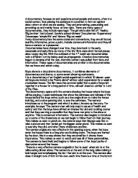We used this in an exercise we did for ‘Blue Remembered Hills’, in which we constructed a still image representing each scene. For each of these images, a member of the group would give a short narration, during which they would stay in character. While they were doing this they had to continue acting, viewing the scene from their character’s point of view. This meant they showed their characters emotions during the narration, making it quite clear which of the characters they liked/disliked and how they feel about what’s going on. The narrator would expand on the still image and tell the audience how it fits in with the rest of the scene, and perhaps why it is significant. The fact that we were playing young children meant that, to do it realistically, the narration had to be simple. We used only terms that children of that age might use and understand, and we made sure that there was little subtlety.
Role Play
In preparation for a piece of drama, actors will often play their characters in situations other than those in the play. This is done mainly to increase the actor’s understanding of the character, as they have to think about how they would react to these new situations.
Still Image
To create a ‘still image’ the actors involved simply adopt the position and expression of their character at a single moment from a scene. We have used this technique on a number of occasions as preparation for a performance. The most recent example was in preparation for a peace from ‘Blue Remembered Hills’, during which we, as a group, created a single still image from each scene of the play. Our final performance was only a single scene, but this was designed to give a better understanding of the whole plot. The idea behind this was to summarise each scene, showing a particularly significant point. For example, for the first scene (featuring only Willy and Peter) we chose the image of Peter sitting on Willy, and terrifying him with the promise of a spit in the face. We chose this moment as we thought it gave a clear impression of the ‘social’ ranking early on. The main purpose of this scene seems to have been to assert Peter’s dominance, so to summarise the scene we simply showed it in it’s least subtle form (Peter being physically above Willy, looking down upon him)
The fact that there were only two characters involved made the decision relatively easy. When many characters are on stage it is difficult to find a single moment that reflects the emotion and status of all of them. In scene four, the boys drive a squirrel out of a tree, and eventually kill it. All the boys feel driven and afraid/guilty to different degrees, and this had to be shown in the image. The point we chose was that of the boys charging towards towards the squirrel, as their positions would show their eagerness. Peter, naturally, is leading the attack, followed by John, then a reluctant Willy. Raymond is making a feeble attempt to hold them back. This was a slight modification of the stage directions, but we felt it was the best way to give the gist of the scene.
I found that using still images gave us the opportunity to put considerably more thought into facial expressions, which may not have been present had we been acting the scene normally. Once we were into the chosen positions our expressions were all we had to consider, and that seemed to be very helpful.







